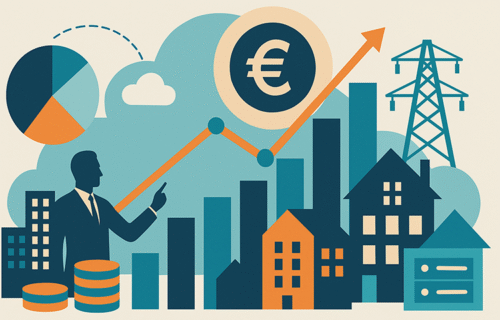As 2025 draws to a close, investors across Europe are repositioning rather than retreating. Inflation is easing, central banks are signalling interest-rate cuts for 2026, and liquidity is gradually returning to risk assets. Yet confidence remains fragile. Political volatility, uneven growth across EU economies and rising energy and technology demands are forcing asset owners to rethink how and where they deploy capital, particularly across private equity, infrastructure, private debt and real estate.
The investment mood in late 2025 is cautious but deliberate. The post-pandemic era of rapid expansion has been replaced by a cycle of measured discipline. Institutional and family investors are trimming exposure to opaque or illiquid strategies and reallocating toward income-producing real assets and infrastructure with inflation-linked revenues. In Central and Eastern Europe this shift is visible in the steady inflow to regulated real-estate funds and renewable-energy platforms capable of delivering yield without heavy leverage.
After two years of market shocks and liquidity squeezes, most investors now prioritise predictable cash flow and flexible exit routes. As one Bratislava-based fund manager observed, the priority is no longer growth at any cost but building portfolios that can breathe with the market.
Fundraising across Europe has become highly concentrated. In 2025, capital flowed mainly to large, sector-specialist managers with proven operational credentials. In Central Europe, private-equity activity held steady in deal count but values were driven by a handful of mid-market control deals and buy-and-build strategies. Countries such as the Czech Republic and Poland continued to dominate volumes, while late-stage growth capital remained thin.
For 2026, limited partners are expected to reinvest proceeds from maturing funds into targeted thematic strategies such as healthcare, energy services and digital infrastructure, while avoiding broad generalist buyout vehicles. With rate cuts likely by mid-year, a modest reopening of the exit market is anticipated, though fundraising will remain slow for emerging managers.
Direct lending remained one of the most resilient private-market segments in 2025, but fundraisings took longer and became more selective. In Central Europe, lenders backed sponsor-led refinancings and platform roll-ups, while new interest emerged in opportunistic and special-situations credit as borrowers adapted to prolonged high rates.
As liquidity returns, 2026 is shaping into a two-track market. Capital is expected to continue flowing to top-tier direct lenders and hybrid vehicles offering both debt and equity upside. At the same time, secondary trading in private credit is expanding as investors seek to unlock liquidity from older vintages. Analysts forecast that regional defaults should decline into mid-2026, supporting new issuance and refinancing across Central Europe’s mid-market companies.
Infrastructure remains the standout winner in 2025’s capital flows. Globally, fundraising for unlisted infrastructure reached record highs, while Europe channelled unprecedented sums into power generation, grid expansion and digital connectivity. In Central and Eastern Europe, energy transition remains the dominant theme, with heavy investment into renewables, storage and cross-border grid projects in Poland, Hungary and Romania.
The coming year is expected to extend that momentum. As AI and data-centre power demand accelerates, investors see opportunity at the intersection of digital infrastructure and energy security. Managers predict that 2026 will bring more partnerships between funds, utilities and public-sector agencies, focusing on co-investment and shared risk rather than outright ownership. The sector’s long-term contracts and inflation-protected income continue to make it the most sought-after asset class in the region.
After two years of correction, Europe’s property market is stabilising. In Central and Eastern Europe, investment volumes rebounded by more than fifty percent in the first half of 2025, led by the Czech Republic, Slovakia and Romania. Capital continues to avoid outdated office buildings but is flowing strongly into logistics, living sectors, retail parks and data-centre-ready assets.
Investors are adjusting to higher financing costs by favouring joint-venture and club-deal structures that spread exposure while maintaining control over capital expenditure. ESG retrofits and energy efficiency remain non-negotiable conditions for new funding. As interest rates begin to ease in 2026, analysts expect more transaction activity and selective repricing, with prime green offices and modern industrial assets likely to lead the recovery.
The fusion of real estate, infrastructure and technology is redefining capital allocation. Data-centre development has emerged as one of the most dynamic investment niches worldwide. In 2025, hyperscale and edge facilities posted record occupancy, and power constraints turned grid access into a strategic asset. In Europe, particularly in Warsaw, Bucharest and Budapest, funds are forming hybrid vehicles that combine real-estate ownership with infrastructure-style income models.
This convergence is expected to intensify through 2026 as demand for AI-driven computing continues to surge. Investors view it as both a growth opportunity and a defensive play, linking long-term digital expansion with predictable infrastructure cash flow.
Across all asset classes, investors are approaching 2026 with a measured sense of optimism. Monetary easing should help narrow pricing gaps, revive exit markets and unlock debt refinancing, while infrastructure remains the anchor for long-term capital. Real estate is entering a gradual, sector-led recovery. Private credit continues to offer liquidity and yield, and private equity is recalibrating toward operational depth and faster, more focused execution.
For Central and Eastern Europe, the message is clear: capital will keep flowing where fundamentals are tangible — in energy transition, logistics, living and data-driven infrastructure — while it will continue to bypass speculative or over-leveraged segments. As one Vienna-based fund-of-funds manager observed, 2026 may not deliver a boom, but it will mark the year when disciplined investors quietly rebuild their advantage.
Produced by CIJ.World Newsroom as part of the publication’s ongoing analysis of investment trends and capital flows shaping the Central and Eastern European markets in 2026.
